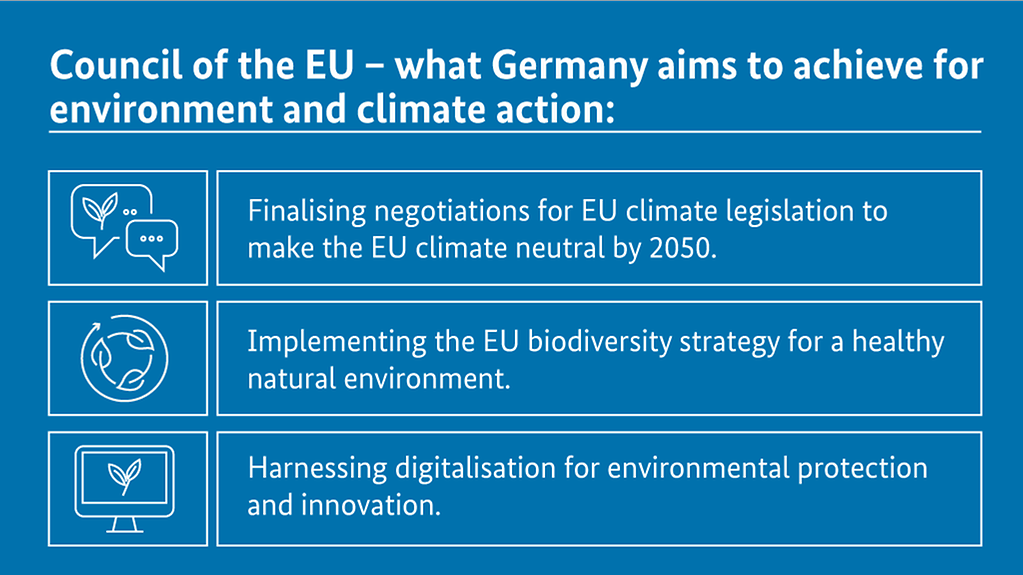Goals of the German Presidency of the Council of the EU
The climate and environmental crisis has "lost nothing of its urgency" stressed Federal Environment Minister Svenja Schulze following a meeting of EU environment ministers. Europe’s post-coronavirus recovery should thus go hand in hand with ambitious and effective climate action and environmental measures, she declared. What objectives does the German Presidency of the Council of the European Union pursue in the field of environmental protection and climate action?
2 min reading time

The main environmental and climate goals of the German Presidency of the Council of the European Union
The diagram is entitled ‚Presidency of the Council of the EU - what Germany aims to achieve for environment and climate action. It depicts the three main environmental and climate goals of Germany’s Presidency of the Council of the European Union.
- Finalising negotiations for EU climate legislation to make the EU climate neutral by 2050
- Implementing the EU biodiversity strategy for a healthy natural environment
- Harnessing digitalisation for environmental protection and innovation.
Photo: Bundesregierung
What is Germany’s climate policy objective during its Presidency of the Council of the European Union?
Under the terms of the Paris Agreement on climate change, the EU committed to achieving greenhouse gas neutrality by 2050. The German government is now pushing for EU climate legislation that will translate this political commitment into a legal commitment for all EU member states. The European Commission has proposed reducing emissions to 50-55 per cent of the 1990 levels by 2030 as an interim step. The German government welcomes these ideas. Chancellor Angela Merkel is convinced that there can only be a global solution to climate change if Europe becomes the trailblazer in the field of climate action.
What would Germany like to achieve in terms of species diversity?
The German government is working to achieve EU-wide binding goals and specific measures to halt the ongoing loss of biodiversity. During its Presidency it will be advocating the implementation of the EU’s biodiversity strategy, which provides for annual investments of 20 billion euros in biodiversity from both EU and national sources, as well as from the private sector. The cash is to be channelled, for instance, into developing organic farming and biodiversity-rich landscape elements, as well as planting three billion trees by 2030. Another important goal is to reduce the use of pesticides by 50 per cent by 2030.
How does Germany intend to harness digitalisation to advance environmental protection?
The EU is to be a trailblazer in the field of sustainable digitalisation. That is another important goal of Germany’s Presidency. But what exactly does that mean? Digitalisation itself is to be environmentally sound and climate-friendly. In this way digital technology can be used to protect the environment, the climate and natural resources, for instance by networking public transport systems and reducing the energy used by computing centres.